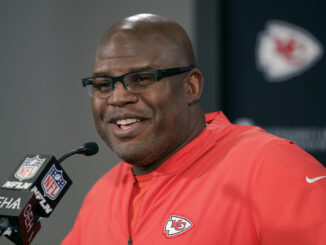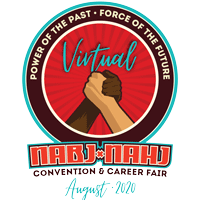
By Raymond Lucas Jr.
The National Association of Black Journalists’ Student Multimedia Project may soon be celebrating 31 years with a new name in honor of Dr. Sheila Brooks, CEO of SRB Communications and founder of the program that has been integral in training many successful Black journalists and media professionals in the industry today. The NABJ board will vote on naming the program in Brooks’ honor on Aug. 8.
Since 1990, selected students have spent the week of the convention working with professional journalists. Their work appears online, in the NABJ Monitor Newspaper and on the NABJ News broadcast.
After trying and failing three times, Dr. Brooks saw her dream come to life in 1989, when the board approved the idea. The first project launched in 1990.
Even though she was confident in her idea, the success of the program has surprised her. Current members of the program hear from former student project members of their experiences as they interview them or research background on previous years’ websites for stories. Former “NABJ Babies” continually come back to mentor a new crop of students.
In an interview Aug. 5, Dr. Brooks reflected on a new virtual era for the program, the key to making it successful and her advice for future journalists. Her comments have been edited for space.
How do you feel about the virtual student newsroom this year?
I think it’s a wonderful change because it gives our young people just another opportunity to gain some other skills that they didn’t have, those digital skills and the technical skills that come with those digital skills. It’s a great thing because guess what? We’re in the real world right now, because that’s what the real world and newsrooms are doing. They’re reporting remotely. They’re working virtually.
How satisfying is it for you when you see Student Projects alumni become successful journalists?
It is so incredibly rewarding and fulfilling to see so many young people who have come through this week-long, practical experience in student projects to become some reporter or producer or news manager at any newsroom across the country. It’s such a rewarding and fulfilling opportunity for them as well.
What is one of the most memorable moments for you from the program?
I think that there are so many memorable moments in this program from over the years, particularly those first 10 years where I ran the program. The ones that I remember the most are making sure when that clock turns 7 a.m., I said, ‘Lock the doors.’ It was like that, you know, Lock the doors. They can’t come in. And oh, yeah, there were several that they didn’t come in that newsroom that day when they didn’t come in for hours because we made sure we had our news meetings, gave our assignments, sent them out on their stories. And then I would deal with those couple, two or three that were late. But you could not be late. You could not be late to that newsroom. You could not be late to file any story. You could not be late for an interview for a scheduled story. I did not tolerate it. You had to meet deadlines because we know in the real world you must meet your deadlines. And that’s something that I did not tolerate.
What differences do you see in the Student Multimedia Project today compared to when it first started?
I think that truly the only difference between these virtual student projects now and 31 years ago when we first started is simply that we’ve gone digital. We’ve gone digital at a time that convergence in news is already happening in newsrooms across the country. So why not have this opportunity for you now? We know we were forced into it. It wasn’t something we thought to do. But once it occurred, we figured it out. That’s what we as black journalists do. We figure it out so that we can learn and we can teach. That way we can continue to look at the legacy that so many of you enjoy and so many others for generations to come will enjoy.”
What advice do you have for this year’s wave of students?
The best advice that I can give all of you is to be vigilant in your work, to be diligent in your work and to learn as much as you can, because we are digital. It’s a whole new world out there and those new opportunities in the newsrooms, those jobs are going to be in more demand than ever. If you get the skills that you need now, and particularly in this experience, then I know that it’s going to be the best experience that you could ever have. …
[Then] you have to return. You have to return and you have to teach someone else. You have to give back to the bridge that brought you across. We have to continue to leave a legacy for when we are all gone. So many other young people come along… we have to teach our own.
How do you feel about the proposal to rename the NABJ student projects in your honor?
I only heard about this late last week… It touches my heart, it’s a heartfelt honor. Whether the board decides to accept that proposal or not, I still stand committed to this project, as I have from the very beginning. I still stand committed to this organization, to all the young people and the mentors who have come through this organization, because even though this was a vision of mine, it takes a village to make it happen and that’s what’s happened over the years.
When I first came up with the idea in 1986, when I was secretary on the national board, you know, when you’re a secretary, all you do is take minutes. You don’t have a project or an initiative. So I wanted to give back. I wanted us, the organization to leave a legacy for our young people. That’s what I was looking for. I want you to know that proposal got turned down by the board of directors three times before it was approved in 1989. I presented that proposal to create this project from 1986 to 1989. We just weren’t doing those kinds of projects for our young people that we were focused on a lot of the professional development for our professional journalists, which, you know, I can understand. But we were always committed to young people.
I came along with the vision to create the student projects, but it did take a board of directors to certainly approve it. It did take scores of mentors over all the years to make it happen and to keep it going. I ran the project for the first 10 years. I mean, for the first 10 years, Sunday to Sunday, the young people didn’t have a life, I didn’t have a life and mentors didn’t have a life.
I am humbled. I am honored that a proposal would even be submitted to name this project after me, and particularly because I’m still living. I have to say that because we all know that usually, those kinds of things happen when somebody passes away. So if by chance that this board agrees to name the project in honor of Dr. Sheila Brooks, I will continue to be committed to this organization. I will continue to give selflessly, as I always have, and I will continue to be committed to the best organization in this entire world.




Be the first to comment